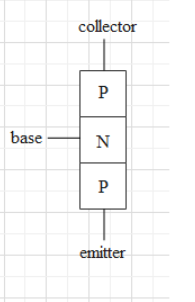
When a p-n-p transistor is operated in a saturation region, then its _ _ _ _ _ _ _ _ _ _ _ _ _ .
A. Base-emitter junction is forward biased and base-collector junction is reverse biased.
B. Both base-emitter and base-collector junctions are reverse biased.
C. Both base-emitter and base-collector junctions are forward biased.
D. Base-emitter junction is reversed biased and base-collector junction is forward biased.
Answer
532.5k+ views
Hint: When a transistor is operated in a saturation region, the emitter and the collector terminals are at higher potential. When the anode terminal of a junction diode is at higher potential than that of the cathode, the junction diode is said to be forward biased.
Complete answer:
A transistor is a semiconductor device, which is formed by fusing two junction diodes. When the anodes of the two diodes are fused, the transistor is called an n-p-n transistor. When the cathodes of the two diodes are fused, the transistor is called a p-n-p transistor.
A transistor consists of three parts – a collector, an emitter and a base. The middle part is base.
Consider a p-n-p transistor. In a p-n-p transistor, the outer ends (terminal) of the emitter and the collector are anodes (positive terminals). And the terminal of the base is a cathode.

When a transistor is operated in a saturation region, the emitter and the collector terminals are at higher potential. When the anode terminal of a junction diode is at higher potential than that of the cathode, the junction diode is said to be forward biased.
Since in a p-n-p transistor the emitter and collector are the anodes, they are at higher potential. Hence, both base-emitter and base-collector junctions are forward biased.
This means that the correct option is C.
Note:
When the both junctions are forward biased, a high amount current will flow in the transistor. Therefore, the resistance of the circuit is very low.
In case of a n-p-n transition, in the saturation region, both junctions will be reverse biased. Hence, no current will flow and the resistance will be high.
Complete answer:
A transistor is a semiconductor device, which is formed by fusing two junction diodes. When the anodes of the two diodes are fused, the transistor is called an n-p-n transistor. When the cathodes of the two diodes are fused, the transistor is called a p-n-p transistor.
A transistor consists of three parts – a collector, an emitter and a base. The middle part is base.
Consider a p-n-p transistor. In a p-n-p transistor, the outer ends (terminal) of the emitter and the collector are anodes (positive terminals). And the terminal of the base is a cathode.

When a transistor is operated in a saturation region, the emitter and the collector terminals are at higher potential. When the anode terminal of a junction diode is at higher potential than that of the cathode, the junction diode is said to be forward biased.
Since in a p-n-p transistor the emitter and collector are the anodes, they are at higher potential. Hence, both base-emitter and base-collector junctions are forward biased.
This means that the correct option is C.
Note:
When the both junctions are forward biased, a high amount current will flow in the transistor. Therefore, the resistance of the circuit is very low.
In case of a n-p-n transition, in the saturation region, both junctions will be reverse biased. Hence, no current will flow and the resistance will be high.
Recently Updated Pages
Master Class 12 Business Studies: Engaging Questions & Answers for Success

Master Class 12 Biology: Engaging Questions & Answers for Success

Master Class 12 Physics: Engaging Questions & Answers for Success

Class 12 Question and Answer - Your Ultimate Solutions Guide

Master Class 12 English: Engaging Questions & Answers for Success

Master Class 12 Economics: Engaging Questions & Answers for Success

Trending doubts
Which are the Top 10 Largest Countries of the World?

What is transplantation in agriculture class 12 biology CBSE

Differentiate between homogeneous and heterogeneous class 12 chemistry CBSE

Why is the cell called the structural and functional class 12 biology CBSE

Who discovered the cell and how class 12 biology CBSE

What is the Full Form of PVC, PET, HDPE, LDPE, PP and PS ?




